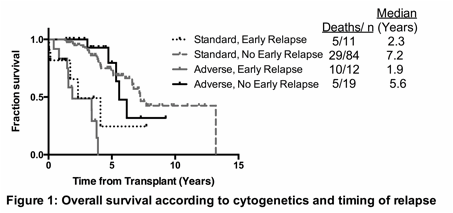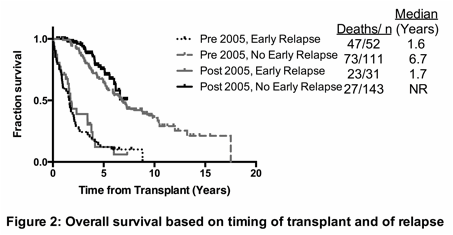Abstract
High dose therapy with autologous stem cell transplant (ASCT) represents the standard of care for untreated patients with multiple myeloma (MM) who are young and fit. Novel agents are changing the landscape of pre- and post-ASCT therapies, but benefits may not apply to all patients. We report 338 MM patients treated with up-front ASCT at University College Hospital London from September 1993 - December 2010.
Patient characteristics are described in Table 1. 90 (27%) received novel agents (thalidomide, bortezomib or lenalidomide) prior to transplant, and the remainder had VAD (vincristine, doxorubicin, dexamethasone)-based regimens. Most patients (64%) had 1 line of therapy prior to ASCT, 26% had 2 lines and 11% >/=3 lines. Responses to first line therapy were 24% >/= VGPR, 45% PR, ORR 69%. Best response prior to ASCT was: 27% >/= VGPR, 59% PR, ORR of 86%. 42 patients (12%) had stable disease or worse pre-ASCT.
Baseline characteristics of patients and induction therapies,
| Parameter . | Number (%) . |
|---|---|
| Age at ASCT (Years) | 57.4 (Range 34 - 70) |
| Male | 212 (62.8) |
| Chain Isotype | |
| - IgG | 188 (55.6) |
| - IgA | 69 (20.4) |
| - Light Chain | 56 (16.6) |
| - Other (IgM/ IgD/ non-secretory) | 25 (7.4) |
| CD56 Status (available in 113, 34%) | |
| - Positive | 77 (22.8) |
| - Negative | 36 (10.7) |
| Cytogenetics Risk Group (available in 126, 37%) | |
| - Normal/ Neutral | 95 (28.1) |
| - High Risk* | 31 (9.2) |
| ISS Stage (available in 240, 70%) | |
| - 1 | 117 (34.6) |
| - 2 | 61 (18.0) |
| - 3 | 62 (18.3) |
| 1st Line Therapy (available in 330, 97.6%) | |
| - VAD/ anthracycline-based | 280 (82.8) |
| - Thalidomide-based | 36 (10.7) |
| - Other | 14 (4.1) |
| Received Post-ASCT Maintenance/ Consolidation | 133 (39.3) |
| Parameter . | Number (%) . |
|---|---|
| Age at ASCT (Years) | 57.4 (Range 34 - 70) |
| Male | 212 (62.8) |
| Chain Isotype | |
| - IgG | 188 (55.6) |
| - IgA | 69 (20.4) |
| - Light Chain | 56 (16.6) |
| - Other (IgM/ IgD/ non-secretory) | 25 (7.4) |
| CD56 Status (available in 113, 34%) | |
| - Positive | 77 (22.8) |
| - Negative | 36 (10.7) |
| Cytogenetics Risk Group (available in 126, 37%) | |
| - Normal/ Neutral | 95 (28.1) |
| - High Risk* | 31 (9.2) |
| ISS Stage (available in 240, 70%) | |
| - 1 | 117 (34.6) |
| - 2 | 61 (18.0) |
| - 3 | 62 (18.3) |
| 1st Line Therapy (available in 330, 97.6%) | |
| - VAD/ anthracycline-based | 280 (82.8) |
| - Thalidomide-based | 36 (10.7) |
| - Other | 14 (4.1) |
| Received Post-ASCT Maintenance/ Consolidation | 133 (39.3) |
Defined as t(4:14), t(14;16), 1q gain, and/or 17p loss.
Transplant-related mortality at 100 days was 3.3%, 166 patients (49%) attained >/= VGPR at 3 months and 126 (37%) PR. Maintenance/consolidation regimens were interferon or thalidomide-based. Median follow-up was 6.1 yrs, progression-free survival (PFS) 2.0 yrs and overall survival was (OS) 5.8 yrs from ASCT and 6.8 yrs from diagnosis. 266 patients have relapsed, and 169 have died.
On multivariate analysis, international staging system (ISS) stage 1, female gender, use of novel agents first-line and disease response (>/=VGPR pre- and 3 months post-ASCT) predicted longer PFS (p's < 0.05). Timing of relapse was the most important predictor of survival (median OS 1.6yrs if relapse within 12 months vs 7.2yrs if not, HR = 6.7, p<0.001. Shorter OS was also associated with male gender, advanced ISS, non-IgG isotype, CD56-negativity, older age at ASCT, <PR post ASCT (p's < 0.05) and later year of ASCT (median OS 6.2 yrs 2005-10 v 4.9 yrs 1993-2004, HR = 0.8, p = 0.006). Use of novel agents at first line predicted longer OS on univariate but not multivariate analysis. Prior lines of therapy and time from diagnosis to ASCT did not impact PFS or OS. Post-ASCT maintenance/ consolidation therapy was associated with prolonged PFS (adj HR 0.6, [95% CI 0.4-0.8] and OS (adj HR 0.5 [0.3-0.7]. Adverse cytogenetics (CGN) was associated with reduced PFS (HR 1.7 [1.1 – 2.7]) and OS (HR 2.2 [1.2-4.0]). In patients with adverse CGN who did not relapse early, OS was similar to patients with standard risk CGN (OS 5.6 yrs v 7.2 yrs, p = NS, Fig 1). Outcomes for those relapsing early were similar in pre-2005 and later (>/= 2005) cohorts (OS 1.6 v 1.7 yrs, p = NS, Fig 2).
Median post-relapse survival (PRS) was 2.6 yrs. Factors predicting longer PRS included IgG isotype, CD56-positivity, later year of ASCT and of relapse, younger age at ASCT, longer PFS from ASCT and the use of novel agents at relapse. Patients relapsing in 2005 and later had longer PRS (3.6 v 1.3 yrs, HR = 0.4, p = 0.0001). Prior treatment with maintenance/consolidation did not impact PRS (PRS 3.1 v 2.4 yrs, p = NS).
These data indicate that post-ASCT strategies and choice of agent at relapse may be as important determinants of outcome as disease response pre-ASCT. Early relapse was the most important predictor of death following ASCT and may outweigh the impact of adverse CGN. The adverse outcome of patients relapsing early is not salvaged using contemporary treatment strategies at relapse. The benefit of CD56 expression on OS, but not on PFS suggests this denotes disease that remains chemo-responsive disease through relapses. Maintenance or consolidation therapy following ASCT appears to prolong PFS and OS without impacting post-relapse survival.
No relevant conflicts of interest to declare.
Author notes
Asterisk with author names denotes non-ASH members.



This feature is available to Subscribers Only
Sign In or Create an Account Close Modal